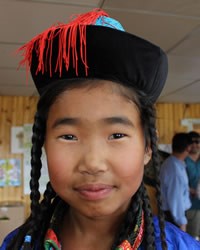The Northern Mongolians, also known as the Mongolian Buriats, are believed to be the descendants of western Mongols and northern Siberians. Of the large number of Mongolian Buriats, only a relatively small number live in Mongolia. They primarily inhabit the forested lowland regions along the Russia-Mongolia border. The territory that once belonged to their ancestors includes the regions along Lake Baikal, which is located in present-day Siberia. Three quarters of all Mongolian Buriats still live there, in a region that is now known as the Buriat Autonomous Republic. Many of them were either killed or driven out of Russia during the days of Josef Stalin.
Mongolian Buriats are very similar to the Khalka Mongols, particularly in their physical features, dialects and customs. They are often indistinguishable from neighboring Mongol tribes. However, they maintain a number of small differences, the most significant of which is their language. Buriat, their native language, is similar to Halh Mongolian. This is Mongolia's official language, and the Mongolian Buriats speak it. Halh is also their literary language.
Traditionally, Mongolian Buriats were nomadic shepherds who raised horses, cattle, sheep, goats and a few camels. Today, many still raise horses and sheep. Others have jobs in wood-related industries or coal mines; some trap animals; and many work on collective farms. Others are in the fishing industry.
A number of Northern Mongolians still live as semi-nomadic herdsmen, migrating seasonally with their animals. Their dwellings are portable gers or yurts, which are round felt tents that have brightly painted wooden doors. Urban Northern Mongolians live in apartment complexes.
Due to the harshness of the climate in Mongolia, the Mongolian Buriats people consume much fat and meat (mainly mutton) during winter, and dairy products such as yogurt, cheese, and sour cream during summer. Their favorite drink is airag, which is fermented mare's milk. They also eat steamed or fried dumplings.
In their traditional social organization, Mongolian Buriats were separated into nobility, commoners and slaves. Their society was based on the clan (extended family) or lineage. A man's home, political position, inheritance and status were all determined by his clan membership. Formerly, marriages were arranged by the parents, whereas today, most marriages are initiated by the couples themselves. Sadly, the divorce rate has increased in recent years.
Mongolian Buriats love music, folk dances, chess and sporting events. Every July, the ancient Naadam festival is celebrated throughout Mongolia. Sporting events are held in horse racing, archery and wrestling. Mongolian peoples like the Buriats have their own style of wrestling called Buhe-Barildaan, which dates back to the days of the Mongol Empire.
Mongolian Buriats were traditionally shamanists (believed in an unseen world of gods, demons, and spirits). They viewed the spirit world as a reflection of the natural world. They believed that when someone died he would pass over into the spirit world and assume his proper role as either a good or evil spirit. Evil men were thought to become devils, while great men became gods. The people depended on shamans (medicine men) to cure the sick by magic, communicate with the gods, and control events.
Most Mongolian Buriats have practiced Tibetan Buddhism since the late 1500s. By 1900, Mongolia was the most religious nation on earth, with more than half of its males serving as priests in Buddhist monasteries. Today, about half of Mongolian Buriats are atheists. Many others have returned to the Buddhist beliefs of their forefathers, but their form of Buddhism is still blended with shamanism.
Rape, murder, alcoholism and violence are major problems in Mongolia's urban areas today. Many young people are also involved in criminal gangs. Mongolian Buriats need protection from urban violence, but they also need the spiritual strength to rise above where they are now. Only Jesus Christ can guide their way.
Pray that God's church in Mongolia would grow in deeper discipleship and greater vision to reach not only the Mongolian Buriats but other Tibetan Buddhist peoples.
Pray for the Holy Spirit to give Mongolian Buriats freedom from alcoholism, violence and divorce as a testimony of what he can do to bless a community.
Ask God to raise teams of intercessors who will faithfully stand in the gap for Mongolian Buriats.
Scripture Prayers for the Buriat, Mongolia in Mongolia.
https://en.wikipedia.org/wiki/State_of_Buryat-Mongolia
https://correctmongolia.com/mongolian-buryat/
https://eurasia.sil.org/culture/ethnography/buryat
https://www.amicusmongolia.com/who-are-buryats.html
| Profile Source: Joshua Project |

























